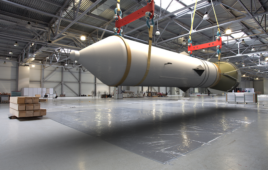It was no trick: an asteroid zoomed past the Earth on the morning of Halloween, providing scientists with quite the treat.
Asteroid 2015 TB145, which has also been nicknamed “Great Pumpkin” by NASA, sailed past the Earth during the morning of Oct. 31 at a distance slightly longer than the space between Earth and moon’s orbit. NASA announced in a press release priot to the event that its researchers had been monitoring the approximately 1,300 foot asteroid using a number of optical observatories. The agency was also aided by the radar capabilities of its Deep Space Network in Gladstone, Calif.
Such an event doesn’t occur too often. According to the Minor Planet Center’s catalog of near-Earth objects, an object of 2015 TB145’s size won’t be this close to the earth until the 2,600 foot asteroid 1999 AN10 flies within 238,000 miles of Earth in August 2027.
Scientists haven’t known about the asteroid for long. In fact, it wasn’t until Oct. 10 that 2015 TB145 was spotted by University of Hawaii’s Panoramic Survey Telescope and Rapid Response System (Pan-STARRS-1). Despite the fact that they recently learned of the asteroid, NASA has a good grasp of 2015 TB145’s trajectory, according to Paul Chodas, manager of the Center for Near Earth Object Studies at NASA’ Jet Propulsion Laboratory in Pasadena, Calif.
“At the point of closest approach, it will be no closer than about 300,000 miles — 480,000 kilometers or 1.3 lunar distances,” Chodas said before the fly-by occured.
A person didn’t have to be a NASA scientist to view the Great Pumpkin, though anyone who would have saw it would have needed more than just their eyes.
An asteroid doesn’t have to reach Earth’s orbit to have an influence on the planet – one could effect a myriad of things such as ocean tides or tectonic plates. However, Asteroid 2015 TB145 had no such impact because its gravitational influence was too small. The moon was also unaltered by the flyby.
The infrequency of such an event is just one of a few factors which made the event special.
Prior to the flyby, Lance Benner of NASA’s Jet Propulsion Laborartory, who leads NASA’s asteroid research program, said 2015 TB145’s size and close flyby made it one of the best asteroids for radar imaging in several years.
The Center for New Earth Object (NEO) Studies is the central figure behind obtaining NEO data analysis in NASA’s Near-Earth Object Observation Program. The group is also involved with the astronomers and scientists throughout the world who monitor skies for asteroids that could potentially endanger Earth.
As the asteroid passed by, scientists used the Deep Space Network’s 110 foot DSS 13 antenna to bounce radio waves off 2015 TB145. Also assisting in the work was the National Radio Astronomy Observatory’s Green Bank Telescope in Green Bank, W.V., and the National Astronomy and Ionosphere Center’s Arecibo Observatory, in Puerto Rico, both of which collected radar echoes during the flyby.
More information on asteroids and other larger near-Earth objects can be found at http://neo.jpl.nasa.gov/
Filed Under: Aerospace + defense




